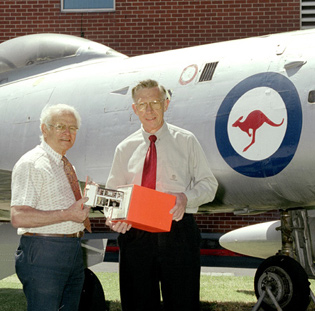David Warren - Inventor of the black box flight recorder

It was David Warren’s interest in the possibility of personally recording music that led to the invention of the world’s first flight recorder or ‘black box’.
David Warren was a research scientist at the Aeronautical Research Laboratory* (ARL) in Melbourne. In the mid-1950’s he was involved in the accident investigations related to the mysterious crash of the world’s first jet-powered commercial aircraft, the Comet. It occurred to Dave that it would be extremely useful if there had been a recording of what had happened in the aeroplane immediately prior to the crash. David then recalled the world’s first miniature recorder that he had recently seen at a trade fair. Suddenly he could visualise such a recorder placed in all aircraft, continually recording details and able to be recovered after a crash.
As with many new concepts, especially in Australia, David had trouble getting his idea off the ground. Eventually David prepared a report that was circulated internationally but produced little interest. David drew on his early work experience as a teacher, remembering ‘show and tell’ was more effective than just ‘tell’. He decided, in his own time, to build a demonstration recorder. Thus the first ‘black box’ was born. It could continually store up to four hours of speech, prior to any accident, as well as flight instrument readings. But, still no interest from any authorities.
It was 1958, during an informal visit to ARL by Sir Robert Hardingham, the former British air Vice-Marshal, that the breakthrough occurred. David Warren was asked, during his lunchtime, to demonstrate his ‘unofficial project’. Straightaway Sir Robert saw the potential. David and his black box were almost immediately on a flight to England. The reception there was most encouraging. The Ministry of Aviation announced that the installation of the black box flight recorder for instrument readings might soon be made mandatory. The black box was also successfully demonstrated in Canada. In America the authorities declined an invitation from the Australian Embassy to demonstrate the device.
Back in Australia, plans were made for further development and production. However, a continuing lack of Australian support meant that, as the idea finally took off around the world, companies in other countries moved ahead with development, capturing the growing market.
It was only after the crash of a Fokker Friendship at Mackay (Queensland) in 1960 that the inquiry judge strongly recommended that black box flight recorders be installed in all airliners. Australia then became the first country in the world to make cockpit-voice recording compulsory.
Since that time, David Warren’s invention, the black box flight recorder, has been universally adopted as a means to investigate accidents and to prevent their recurrence. The black box flight recorder has more than proved itself with its significant contribution to international airline safety.
Read David Warren's biography.

